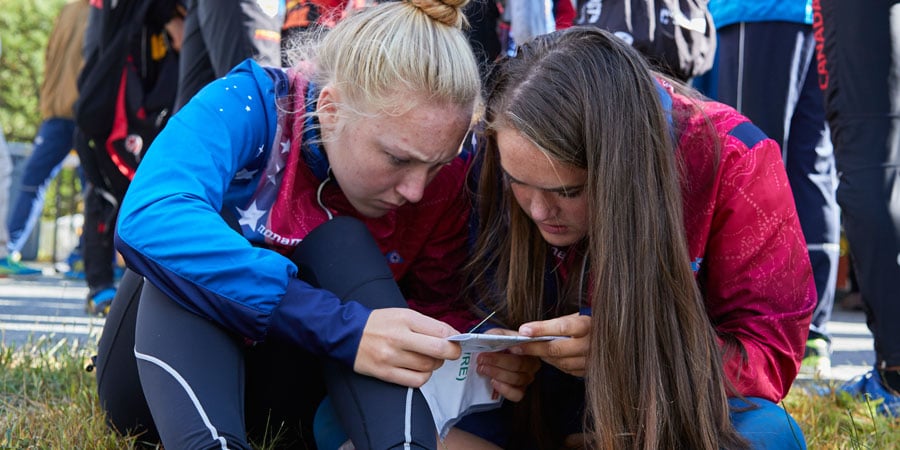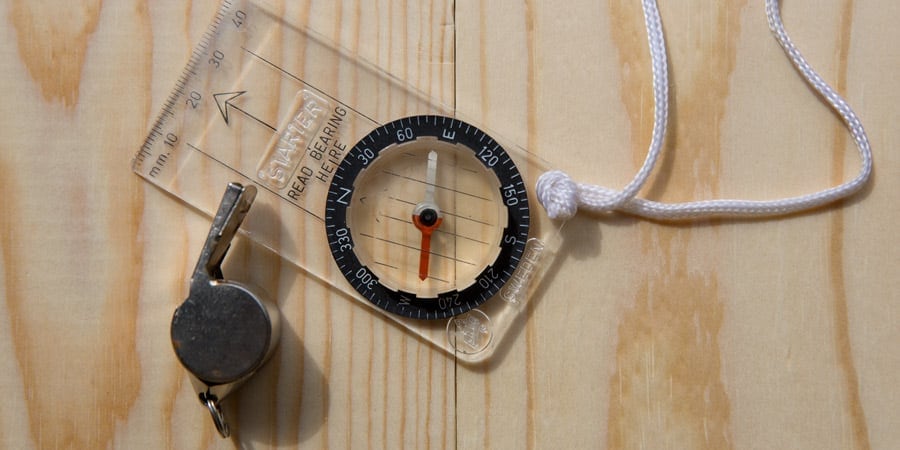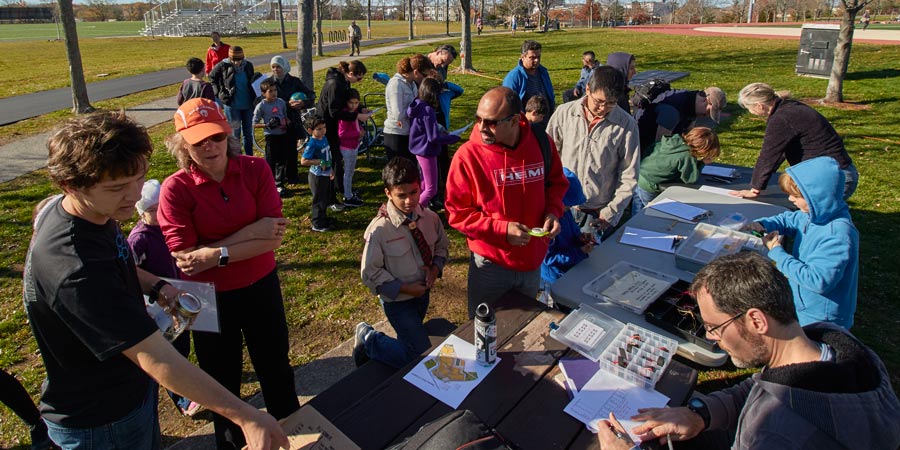Image courtesy of Dave Yee Photography.
If you were born in Scandinavia, you're probably already in the know about orienteering, where the biggest orienteering meets attract upward of 20,000 participants. In the U.S., though, far fewer of us have stumbled onto this delightfully addictive sport.
This article covers the basics about this lesser-known outdoor activity:
- What orienteering is
- Where to learn how to do it
- Gear and clothing needs
- A primer for your first meet
What is Orienteering?

Image courtesy of Dave Yee Photography.
Orienteering ("O" for short) is a timed event across a mostly natural landscape, where participants navigate through a series of checkpoints along the way. The route from one checkpoint to the next isn't marked: Each participant decides the best route on the run (or walk). Meets have courses of varying lengths and difficulty, from beginner to expert.
An orienteer might be described as part trail runner and part map-and-compass geek. Because it requires you to find pre-placed control markers, you experience multiple geocache-esque "I found it!" moments in a single event, though a GPS is not required and not allowed. Orienteers are also like obstacle-course runners, though the obstacles are au naturale and often avoidable through savvy route choices.
Orienteering's Birth and Growth
Orienteering was created in the late 1800s as a navigational competition for members of the Swedish military. Civilians soon joined the fun and the sport has spread throughout the world since then. Today you can find everything from international meets that attract pros to quirky variations where participants might ski, paddle or cycle. Most meets, though, are run-through-the woods local affairs.
Where to Learn About Orienteering

Orienteering Clubs
Orienteering clubs, which put on meets and provide training, are your best place to start. For a state-by-state list of clubs, visit the website of the national organization: Orienteering USA, which also has several articles to help newcomers learn about the sport.
It's also possible to learn more about orienteering from other resources:
- Local parks departments
- Outdoor stores like REI
- Outdoor organizations like Girl Scouts and Boy Scouts
- School teams for elementary-age kids, middle schoolers and high schoolers
Local Meets
Clubs maintain an online calendar of events, at which they offer on-the-spot registration and newcomer instruction. They also rent compasses. So you can walk up and try out a beginner course without any preparation other than finding your way to the event site.
Permanent Courses
Some parks have permanent courses that offer a low-key way to try O on your own schedule. Maps for these courses might be available at the parks or online. The website of a local orienteering club is your best place to find permanent courses in your area.
Gear and Clothing

An appealing aspect of orienteering is that you don't have to buy a bunch of specialized gear and clothing to do it. At a minimum, you need:
- Sturdy outdoor footwear: boots if you're walking and trail runners if you're starting to get a little competitive
- Appropriate outdoor clothes and layers for the weather: Being able to stand up to brush, abrasion and mud is important when you start running more difficult courses, where controls are placed in trickier terrain
- A simple baseplate compass: Lighter is better, so a model with a sighting mirror, or even declination adjustment, is more than you need. Note, too, that you won't need to bring a map because those are provided at every event.
- A safety whistle: in case you need to summon help
Gear for Longer Events
For multihour and multiday events, your gear needs increase. Consult the website of your meet for guidance on what to bring. Our Ten Essentials article and our Trail-Running Checklist are also worth a look.
Note, too, that meet organizers don't always include the word "orienteering" in the name of these longer navigation races, even though orienteering skills and gear will both be needed.
What About a GPS?
Because the sport predates the Global Positioning System by about a century, orienteering is strictly a map-and-compass endeavor. That old-school navigational ethos is part of the sports' appeal—and affordability.
GPS technology is, however, used by advanced orienteers, not for navigation (a rule violation), but rather to analyze performance. Those orienteers record the precise path of their runs, then download that data after the race to critique route choices.
A Primer for Your First Meet
A typical local meet involves several elements:

Image courtesy of Dave Yee Photography.
Registration
At the registration area you sign a waiver, choose a course, pay an event fee and, if you didn't bring one, rent a compass. (You get the map for your course later.) People at the registration area can also direct you to the newcomer instruction area.
The Start
Get in line for the course you picked at registration. A local meet might have from three to seven courses set up. To avoid bunching up runners, start times are staggered, though orienteers on different courses often start in the same wave.

The Map
Your orienteering map is a topographic map that's customized to cover the meet area in rich detail. It includes many symbols unique to orienteering. Declination doesn't come into play, because all orienteering maps align with magnetic north, not true north. That simplifies map reading when you have to navigate while moving quickly.

E-Punch vs. Paper Punch
Every course has a series of controls where you must record your visit. Some meets do that via a simple paper punch hanging from each control marker. Most meets now use controls that you "punch" electronically by inserting an "e-punch" timing stick. If you don't have your own, you can rent an e-punch at the registration area.

Navigating to Controls
You choose your route from one control marker to the next. On beginner courses, you can stick to main trails. Intermediate and advanced courses bring more serious navigation and rugged landscapes into play. Your map has descriptions of the feature on which each control will be found. Written descriptions are used on beginner courses, while special symbols denote control features on more advanced courses.

Punching in at Controls
The same control might be used by two different courses. You're also likely to see controls that aren't on your course, so don't be influenced by the presence of other orienteers. Each control has a unique number to positively identify it. Double-check that identifying number against your control description before punching in because a mispunch disqualifies your time.
At a typical meet you must visit controls in numerical order, though some meets might let you vary which controls you visit and the order in which you visit them. When you register, ask if there's anything special about that meet's format or rules.
The Finish
The finish area is often located near the start area. If you have an e-punch, you'll be able to get a printout of your overall time, and time between each control, at the download station right next to the finish area.
Tips for First-Timers

Image courtesy of Dave Yee Photography.
- Walking—and stopping—are perfectly fine. A common mistake is to run off with only half a notion of where you're headed because it's a "race." Smart route choices can save more time than a speedy pace.
- Don't fret about how you're doing compared to others. Because multiple courses are in play and starts are staggered, you won't really know your order of finish until you see the event results later.
- Go online and familiarize yourself with orienteering maps before the event. The rich detail on a map offers a lot of guidance, but it can also be a little overwhelming trying to figure out what the special symbols mean.

